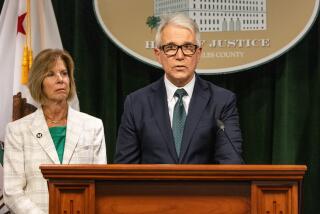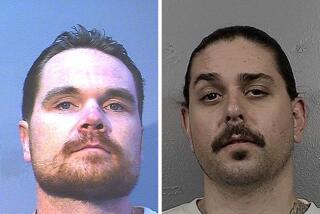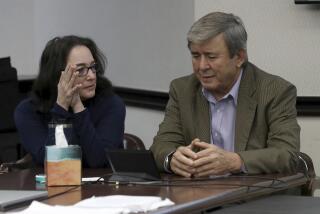Teacher’s Shooting a Story of City’s Worst--and Best
At 8:49 on the morning of Feb. 22, Alfredo Perez, a 30-year-old teacher at Figueroa Elementary School in South-Central Los Angeles, was sitting with a group of fifth-graders in the school’s first-floor library several feet from the tall windows that face east onto the street and fill with morning light.
At 8:50 or so, a medium-caliber bullet, allegedly fired by a teenage gang member at a passing car of rivals, flew across Figueroa Street’s six lanes, passed unscathed through a metal window grate, pierced the glass, and struck Perez on the left side of his forehead inches above the eyebrow.
What happened over the next few hours makes up a story seldom told in the postmodern city, a place where nothing works (so it is said), where civic services falter under the weight of their own bureaucracies, where people inured to more than 7,000 gang-related deaths since 1979 in Los Angeles County are hardly expected to react to yet another shooting.
Nine days after sustaining one of the most grievous head wounds that trauma specialists had seen anyone endure, Perez was alive Saturday and, all things considered, remarkably well in the neurosurgical intensive care unit of Martin Luther King Jr./Drew Medical Center in Willowbrook. He seems to recognize his wife of barely a year, Virginia, herself a public schoolteacher. He understands simple commands. He breathes without a machine’s help. He has flashed the “thumbs up” sign.
His case, the most serious assault on a teacher in the history of the Los Angeles public school system, has attracted world attention, with the pope and the president sending their best wishes. And while the crime has fast become an emblem of the city at its worst, Perez’s rescue and emergency medical care tell a different story, a story of the worst possible outcome prevented by all manner of public servants doing just the right things just in time.
‘He Opened His Right Eye’
At 8:57 that Thursday morning, the Los Angeles City Fire Department received the school’s 911 call. Routed to Station 64 on West 108th Street, the bulletin conveyed only that someone at the school had been shot. Paramedic Russel Arentzoff and his partner that shift, Robert Lind, grabbed a Teletype, checked a map, and with Lind behind the wheel, pulled out of the station at 8:58.
As they raced the 10 blocks to the school, Arentzoff, an 11-year department veteran, assumed the victim was a child. They arrived at 9:02 a.m. Arentzoff ran to the door carrying his trauma box. A school system policeman said: “A teacher’s been shot in the head.”
Hearing that, Arentzoff sent Lind back for the gurney and a spine-immobilization setup and then jogged down the long hall to the library. The kids had been cleared out of the room. He found Perez on his back. Lots of blood. “He had an extremely large hole in his head, an incredibly impressive hole,” Arentzoff said. “He was basically unconscious, but he opened his right eye when I called his name out.”
Arentzoff bandaged the raw hole, noted the lack of an exit wound, and began cutting Perez’s clothes off--searching for other wounds. None. When Lind returned, they secured Perez’s head and neck, strapped an oxygen mask bag to his face, slid a back board under him, and lifted him onto the gurney.
More troubling than the blood loss or even the exposed brain tissue was the fact that Perez was starting to have seizures. That meant his brain was swelling rapidly. Ironically, it is often not the trauma but the brain’s response to it that ends a life, as the swelling tissue presses hard against the skull, crushing nerve centers that control breathing and heartbeat.
Enriching the brain’s supply of oxygen helps check such swelling, and Arentzoff and Lind kept squeezing the bag to pump oxygen into Perez’s lungs all the way to the ambulance. They immediately ran an intravenous line into Perez’s arm to replenish his fluids, which helps maintain blood pressure and prevent shock.
During the 3.7-mile ambulance ride to King Medical Center, Arentzoff, Lind and another firefighter tended to Perez. They called the hospital and said they were on their way with a head trauma, gunshot, pulse and blood pressure OK. They had just plunged another IV line home when they pulled up to the emergency room. It was 9:15.
From the time Station 64 got the 911 call to the moment the big ER doors swung open for the bandaged and stabilized Perez, only 18 minutes had gone by.
Perez may forever remember Feb. 22 as the unluckiest day of his life, but by another accounting he was lucky indeed.
“The fire station was close to the school, the school was close to the hospital,” Arentzoff said. “Everything worked out perfect for him.”
‘The Paramedics Had Done a Great Job’ Several minutes before Perez arrived at the hospital, the public address system and Dr. Kenneth Menchion’s beeper told Menchion that a “code yellow”--the most severe trauma case--was on the way.
Menchion, a surgical resident in his sixth year at King and the head of the trauma team on duty that morning, left the surgical library where he had been reviewing cases and joined team members in the emergency room. They put on gowns, goggles and gloves. When Perez was rolled in, Menchion was not encouraged.
“He had brain tissue coming out of the wound,” he said. “He was bleeding. These people don’t do well. Generally, they end up being counted on for organ procurement. But the paramedics had done a great job keeping his airway open. That was crucial.”
For half an hour, Menchion and the emergency physician and the nurses worked on Perez in the trauma room. A flashlight aimed at his pried-open eyes revealed his pupil reflex was intact--a good sign. He couldn’t talk but he could lift his right arm when asked to move. He hovered somewhere in the fog between coma and consciousness, earning a score of 7 or 8 on the standard 15-point descending coma scale. A 2 or 3 is virtual brain death, candidacy for organ donation.
After rushing him for X-rays, the doctors saw on film that the bullet had torn diagonally across the brain, crossing the midline and lodging in the right rear hemisphere, less than half an inch from the brain stem. “Based on the X-ray, I thought that he would die,” Menchion said.
Without delay, they got Perez to the CAT scanner, which was then unoccupied, and then into an operating room, which was staffed with two anesthesiologists and ready to go. The luck was holding. “We were fortunate we didn’t have any other trauma patients at the time,” Menchion said. “That doesn’t happen very often.”
Dr. Taghi Tirgari, the neurosurgeon on call at the hospital who had been taking part in a weekly physician conference that morning, reviewed the neurological findings: the pupil reflex and the CAT scan, which revealed extensive damage and swelling but also showed that key brain centers had been spared.
Tirgari made the decision to operate.
“There was some hope of saving his life,” he said.
By 11:15, Tirgari was scrubbed and gowned and bent over Perez’s head, saw and scalpel in hand. The surgery went on for nearly 3 1/2 hours. He cut away the burned, blackened flesh where the bullet struck--what traumatologists call a “tattoo.” He cut scalp and skull in an arc from the wound across to the temple, the better to get at the brain. He cleared away as many bone fragments as he could. He removed clotted blood. And he pruned away devastated gray matter, the only tissue incapable of healing itself.
Judging that it would be hazardous to extricate it, he left the bullet in place, where it remains, a glowing white splotch in the gray CAT scan film.
After surgery, Tirgari examined Perez. There was no aggravation of his symptoms. “That was a good sign,” he said.
In the neurosurgical ICU, Perez was placed on a breathing machine, and the usual beeping, whirring array of monitors was supplemented by one that gauged intra-cranial pressure, the fiber-optic probe having been ingeniously inserted into Perez’s skull during surgery. The drug mannitol, which reduces brain swelling, poured constantly into one of Perez’s veins.
For all of this, a statement issued by the hospital the day after surgery was ominous, saying that “this type of injury to the brain is usually fatal or associated with severe neurological impairment.”
After Perez spent six days in the ICU hooked to a ventilator, Dr. George Locke, head of neurosurgery, consulted with his colleagues and had Perez disconnected from the machine. Weaning him of the oxygen-enriched air, they were relieved to find that his brain could still manage the surprisingly complex chemistry and mechanics of respiration.
According to his doctors, Perez is still unable to move his left arm and leg, but that loss may not be permanent. Tirgari said that Perez may walk again, using a cane. He has not spoken, but he understands speech. The idealistic teacher who aspired to be a principal might talk again, Locke speculated, might even teach again in some capacity.
*
Dr. Arthur Fleming, chairman of surgery and head of the trauma service, expressed concern that the publicity surrounding the Perez case might obscure the deeper, if more routine, reality of violence in the community that the hospital serves. He said that 1,000 to 1,500 gunshot victims are brought to the hospital each year.
“Every day, we have human beings who are shot, wounded, killed,” he said. “And nobody seems to care.”
At the same time, the publicity surrounding Perez’s recovery may help the hospital’s reputation, which has been damaged by charges of mismanagement and substandard care. In March 1992, Deputy Nelson Yamamoto, shot three times in a gunfight, died after King doctors gave him inappropriate heart drugs, according to a state medical board investigation last year.
In spite of the high profile of the Perez shooting, he did not receive special care, Fleming said. “Did it make any difference that he was a teacher? Zero.”
For now, the King doctors are continuing to monitor Perez’s progress, guarding against brain swelling and infection and eager to release him to rehabilitation and testing.
In one area, Perez is not likely to be found wanting: the will to live. That is the great intangible, of course, beyond science yet real as can be.
“His wife told me he was a very strong man,” surgeon Menchion said. “I would like to say that the aggressiveness of the care we gave him made the difference, but we’re aggressive with all our patients and they don’t all do as well as he has.”
“When he began to respond,” Locke said, “we got the impression that he had a strong will.”
As for Perez’s family, Locke said, “in the last few days, I’ve seen a definite change in their perception. They have hope.”
Locke said that the hospital has provided Virginia Perez with a room so she can be near her husband. But she had slept very little until the other night, he said. Earlier that day, she had asked her husband to write his name.
“And he did,” Locke said. “ ‘Alfredo.’ ”
More to Read
Sign up for Essential California
The most important California stories and recommendations in your inbox every morning.
You may occasionally receive promotional content from the Los Angeles Times.










